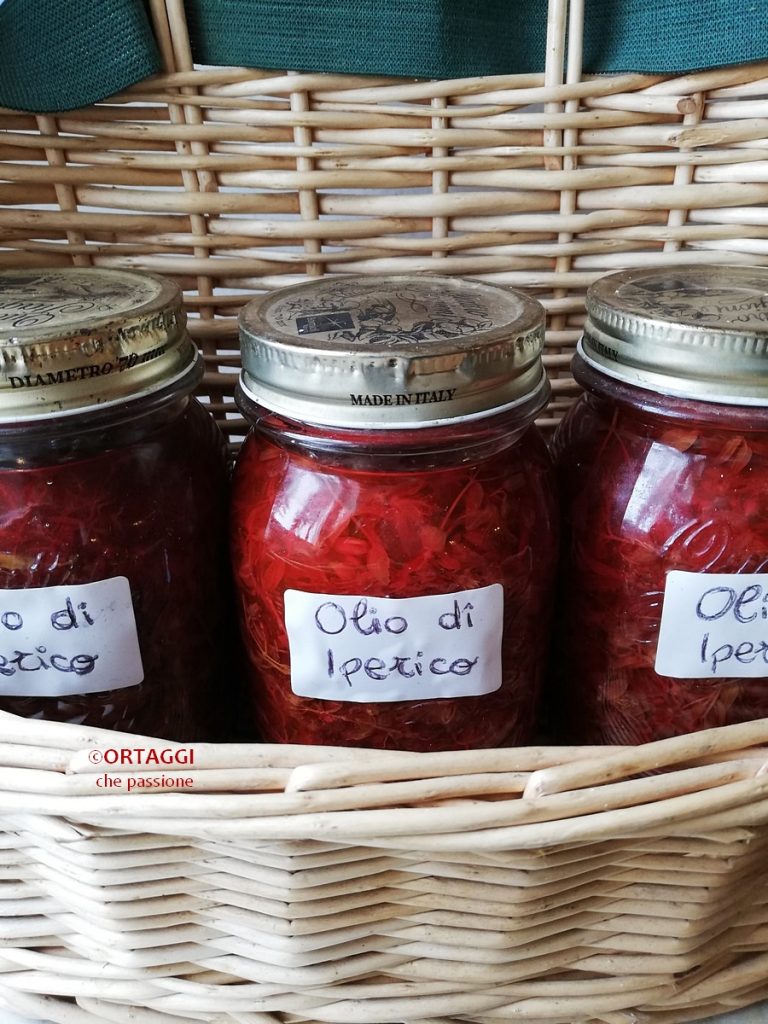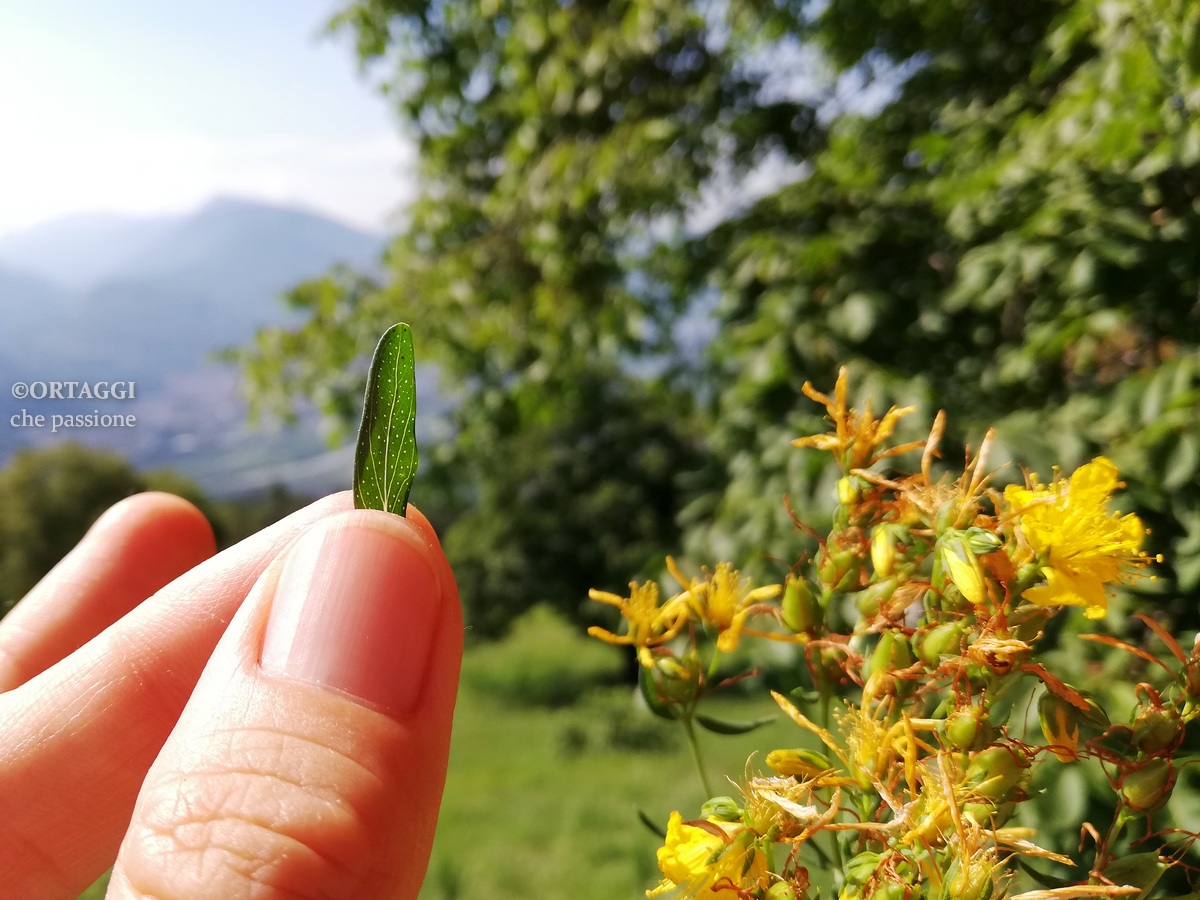Infused oil of St. John’s Wort, commonly known as red oil (or l’ugghiu ciuriddu, sciuriddu) is a healing oily solution, a popular traditional ointment. It can be bought in herbal shops or pharmacies, but making it at home is very easy, following grandmother Benedetta’s recipe.
The perennial plant of St. John’s Wort (Hypericum perforatum) or St. John’s Herb can reach up to a meter in height. It is easily found on roadsides, in uncultivated meadows, and at the edge of cultivated fields.
Traditionally, the collection of these small, intensely yellow flowers is done during the Summer Solstice (between June 20 and June 22) at noon, or on St. John’s Day (June 24) but in reality, these little flowers can be picked anytime when they are fully opened. It is best to collect them away from roads or other pollution sources. The best time for harvesting this wild herb is during the waxing or full moon, in the morning when the dew has evaporated and the sun has not yet burned, so before noon. This is to take advantage of their full energetic and healing power.
BLOOMING SEASON of #StJohnsWort: from April to September.
Tradition recommends harvesting around the summer solstice..
Curiosities about wild herbs

- Difficulty: Very Easy
- Cost: Economical
- Rest time: 30 Days
- Preparation time: 15 Minutes
- Cooking methods: No Cooking
- Seasonality: Spring, Summer
COLLECTION of St. John’s Wort Flowers
Collect St. John’s Wort flowers on a sunny day, from green and healthy branches.
The leaves of the plant are oval and appear perforated with tiny holes when backlit.
The flowers are yellow with 5 petals that, when rubbed, stain the fingers red.
- St. John's Wort Flowers (fresh or dried)
- Oil* (enough to cover the flowers)
*For the ancient recipe, not only the flowers are used but also 50% of the green part of the plant.
**Which oil to use to prepare St. John’s Wort infused oil?
It is recommended to use a cold-pressed organic vegetable oil of known origin, such as extra virgin olive oil, rice oil, sunflower oil (less greasy), corn oil, grape seed oil, or even mixed together. It is better to avoid linseed or almond oil as they quickly and easily become rancid.
Tools
- Jar glass with lid
- Strainer or Funnel
- Gauze cotton or coffee filter
- Spoon or potato masher
- Glass Bottle dark
St. John’s Wort Infused Oil
First, collect the flowers.
Do not wash them, at most, leave them in the open air on a tray to allow the insects to fly away. Use the flowers within a few hours of picking.
Place the fresh tops in a suitably sized jar without pressing too much, add the oil until they are all covered.
Leave the lid unscrewed for 7 – 10 days to allow the moisture from the flowers to evaporate, or cover with a net secured with an elastic band.
After the time has elapsed, you can close the jar hermetically.
Leave to macerate for 30 – 40 days, shaking occasionally, ideally daily. Expose the glass container to the sun to speed up the extraction process of its active ingredients (the Hyperforin must evaporate, while the Hypericin makes the oil red).
It is said that the oil in preparation should not be exposed to the moon, so it should be left in the sun during the day and taken indoors at night.
The St. John’s Wort oil is ready when it has a beautiful deep red color, usually, one month is enough.
Filter with a strainer (or funnel) and a cotton gauze. Press the flowers well with a spoon or inside a potato masher to recover all the infused oil.
Pour it into a dark glass bottle to protect it from the sun and store it in the medicine cabinet in the dark.
Better to use fresh or dried flowers?
Some say it is better to use fresh flowers and others say dried ones.
FRESH FLOWERS: it is better not to seal the oil with fresh tops immediately, but to leave it for at least a week with the lid just resting or with a cotton gauze over it secured with an elastic band, to avoid most risks and side effects.
DRIED FLOWERS: they no longer contain aqueous parts and allow immediate and hermetic sealing of the jar exposed to the sun.
DRIED FLOWERS: they no longer contain aqueous parts and allow immediate and hermetic sealing of the jar exposed to the sun.
TOPICAL USE of St. John’s Wort oil (known as red)
The infused oil after sun exposure is no longer suitable for dietary use. Additionally, the molecules present within it, provided by the medicinal plant St. John’s Wort, are very concentrated and can be dangerous to health.
Use away from eyes and mouth.
Various sources attribute these phytotherapeutic properties:
– prevent and relieve skin disorders: erythema, couperose, psoriasis, and any other redness and chapping problems (emollient for bedsores, diaper rash, chapped hands, cold sores, stretch marks, astringent for acne, boils, vaginal infections and inflammations, ulcerations of the male glans)
– promotes rapid healing of small scratches or wounds or when the scab is already formed
– soothing on insect bites, on cold sores
– excellent as a relaxing massage oil, for back pain, neuralgic and joint pain, swelling, bruises, sprains, gout and rheumatism
– anti-inflammatory and anti-edematous for tired and fatigued legs. If you massage your feet with St. John’s Wort infused oil in the evening before going to bed, you sleep better
– moisturizing for the belly of pregnant women
– stimulates cellular regeneration, making it an excellent anti-wrinkle and anti-aging
– soothing for dry skin of the face, hands, and body
– applied locally, it alleviates hemorrhoids
– applied locally, it alleviates hemorrhoids
Contraindications of St. John’s Wort oil
It is photosensitizing, should never be used before sun exposure or UV rays, as it can irritate the skin and spots may appear. Therefore, it is better to avoid sun exposure after applying it.
It interferes with some medications, it’s better to consult your doctor.
Its use requires the same care as that of a drug.
Its use requires the same care as that of a drug.
How to STORE St. John’s Wort oil
It is best to keep it in a cool place away from direct light. Ideally, it should be stored in a dark bottle (amber or cobalt blue), to preserve its active properties. If well preserved, it can last even a year, but always check the smell and appearance before use, keep in mind that after 12 months it loses some of its properties.
Label to name and date.
Can St. John’s Wort oil be used on the face?
Yes, with some caution. It can be beneficial for dry, irritated, or mature skin, but it is important to know that St. John’s Wort is photosensitizing, so it should never be applied before sun exposure. It’s better to use it in the evening before going to bed, to allow the skin to absorb it without risk.
Is St. John’s Wort oil edible?
Generally, St. John’s Wort oil is not intended for dietary use. There are St. John’s Wort extracts for internal use, but they should only be taken under medical advice, as they can interfere with some medications. If in doubt, it’s always better to ask a health professional.
Where to buy pure and natural St. John’s Wort oil?
The ideal choice is a biological St. John’s Wort oil, cold-pressed, and free of synthetic ingredients. You can find it in herbal shops, bio stores, or online, paying attention to the quality.

